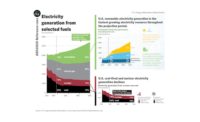Puerto Rico will get 100% of its power from renewable resources by 2050 under legislation signed April 12 by the territory’s governor. There’s a wide consensus that the goal is achievable, perhaps even before 2050. But many questions and disagreements remain over how the island will generate power in the years before then, how much that electricity will cost and how to ensure that Puerto Rico is better prepared for the next major storm.
And amidst these sweeping energy policy changes, the island’s government is expected to privatize its public utility by the end of this year.
“What happens between 2019 and 2050 is the question at this point in time,” says Alap Shah, vice president and director of technologies and services for Black and Veatch’s power business.
The island completely lost power following Hurricane Maria in 2017. Its public utility, the Puerto Rico Electric Power Authority (PREPA) finally restored the last connection in the territory in March 2019, when it restarted an underwater line from the main island to the island of Culebra.
While the current grid is somewhat improved over the decaying grid the territory had before the storm, “If you have the same storm today, you would have the same result,” said Jose Ortiz Vázquez, executive director and CEO of PREPA, at a House Natural Resources Committee hearing on April 9.
Puerto Rico is still reliant on transmission lines that go across the middle of the mountainous island, with most of the generation located south of the northern population centers. Despite repairs, poles, lines and substations are still vulnerable.
“There are 18 substations that have significant damage, and those need to be moved into locations to be more viable for future events,” Bruce Walker, an assistant secretary at the Dept. of Energy, told the House Natural Resources Committee during the April 9 hearing. DOE is recommending a new 1,200-MW to 1,600-MW natural gas plant for cost and reliability reasons. “DOE believes increasing natural gas generating capacity in the San Juan area would be one of the single most valuable investments for PREPA’s long-term recovery. However, pursuing this investment may be at odds with the governor’s goals of 100% renewables,” Walker said.
Shah and many others agree that some use of natural gas will be necessary as a bridging power source until electrical batteries are cheap and large enough to store renewable power at scale.
PREPA issued a draft integrated resource plan (IRP) earlier this year. That draft was rejected by its regulators, the Puerto Rico Energy Bureau, because it did not align with the 100% renewable legislation and relied too much on new or existing natural gas power. A revised IRP, which is expected to have a faster ramp-up to renewables, is expected in May.
Despite this, PREPA has recently entered into a contract with New Fortress Energy to convert two units, totaling 440 MW, at the San Juan power plant from oil to natural gas.
Shah points out that even if the island were to run on 100% renewable energy, wind turbines and solar panels proved vulnerable during Hurricane Maria, underscoring the need for some natural gas turbines in the event of a future storm. Puerto Rico, through its Public-Private Partnerships Authority, issued an RFP on April 16 for 18 small 23-MW diesel or natural gas-powered units to be located around the island for fast-start generation during such an emergency.
As debate rages on what the island’s electric mix will be, there is uncertainty on who will run the system. In January, the P3 authority announced four utilities were finalists to manage and operate all aspects of PREPA’s distribution and transmission system: Duke Energy, Exelon Corp, PSEG Corp, and the ATCO consortium comprised of IEM and Quanta Services. A winner will be selected in the third quarter of 2019 to operate the grid of the soon-to-be privatized PREPA.






Post a comment to this article
Report Abusive Comment